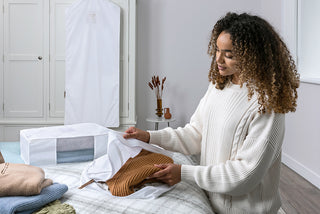The Difference Between Pressing and Ironing
It's easy to damage your clothes unintentionally with an iron. If you apply the wrong setting, the wrong temperature, or keep the iron on for too long, you may leave a mark. This might be anything from a scorch mark to a shiny patch or even melting, depending on the type of fabric. Pressing cloths will prevent these types of damage.

Do you iron your clothes or do you press them?
The words ironing and pressing are sometimes used interchangeably, but they are actually two distinct things. Ironing is the back-and-forth, side-to-side motion that most of us use to remove wrinkles from our clothes.
Pressing is the process of placing an iron on an item of clothing, holding it in place, and then releasing it. Pressing and ironing are very different movements that yield different results.
What is pressing?
The purpose of pressing is to help a garment achieve a certain shape. It requires two things to be successful: 1) as much steam as the fabric can tolerate without causing damage, and 2) a gradual, bit-by-bit action that applies downward pressure to set one area in place before proceeding to the next.
The person pressing will frequently slide the iron ahead to the next spot to press, although this moving action differs greatly from the sliding motion used during ironing. One of the most important tools needed for pressing are pressing cloths.
What are pressing cloths?
A pressing cloth is a piece of fabric or other material that is placed between the iron and the fabric that is being pressed. Pressing cloths shield your fabrics from the heat of the iron.
It's easy to damage your clothes unintentionally with an iron. If you apply the wrong setting, the wrong temperature, or keep the iron on for too long, you may leave a mark. This might be anything from a scorch mark to a shiny patch or even melting, depending on the type of fabric. Pressing cloths will prevent these types of damage.
They can also be used to protect items with graphics. And when pressing cross-stitch or embroidered designs, cloths allow you to press out any wrinkles in the fabric without affecting the texture of the stitches.
If you don't have a steam iron, you can also use pressing cloths to steam fabric. Using moist pressing cloths in combination with an iron set at high temperature will produce the same results as a steam iron.
Types of Pressing Cloths
There are several different types of pressing cloths available. Almost any fabric can be used as a pressing cloth, other than synthetic fabrics which can melt your garment.
Certain fabrics, however, work better as pressing cloths than others. Each of the fabrics listed below offers advantages for various pressing demands.
White Cotton Muslin
A white or unbleached cotton muslin cloth is the most popular type of pressing cloth. It's essential to pick a white or unbleached fabric so color doesn't pass onto your garment from the cloth.
Muslin is ideal for all-purpose pressing. It has a high heat tolerance and thus provides adequate protection for your garment. Muslin pressing cloths work nicely with heavier fabrics, such as flannel prints. They are also useful for steaming since they allow steam to pass through the weave without wetting the fabric.
But muslin’s woven texture may become imprinted on less durable fabrics. Avoid using this type of cloth to press linens or other delicate textiles.
Silk Organza

Silk, despite its smooth and delicate look, is a very strong fabric. It has a high melting point and a fine weave, making it an excellent all-purpose pressing cloth. It's also sheer, so you can see the item you are pressing.
Silk organza is ideal for pressing embellished or embroidered clothes. You can easily tell where there are wrinkles in the fabric and prevent pressing out the stitching or harming the embellishment. Silk organza can be a bit more costly than muslin, but it is a wise investment for such a versatile pressing fabric.
Mesh
Mesh is an excellent choice for pressing garments. It is transparent so you can easily see when all wrinkles have been removed. Because the weave’s gaps allow a lot of steam to get through, this is an excellent choice for use with a steam iron.
If you don't have a steam iron, using a mesh cloth is not a good alternative. Mesh does not hold water so you won't be able to adequately steam your fabric with this type of cloth. Mesh is also not a suitable choice for embroidered or fragile fabrics since it is easy to flatten a design or force the weave pattern into your fabric.
Teflon Cloth
Teflon cloths are not made of fabric. They are made of fine fiberglass mesh that has been coated in Teflon, which is extremely heat resistant. For stickier items, such as those with iron-on patches and appliques, this is the ideal solution.
Because Teflon is simpler to clean than other fabrics, you can continue to use it even if you get adhesive on it. It will both protect your clothes and your iron. Some varieties are transparent, while others are opaque. You can select the version that best meets your needs.
Worsted Wool
Worsted wool cloth is ideal for pressing and steaming wool materials. Wet wool is far more delicate than dry wool. You can steam a wool garment without getting it wet by using a wool cloth. Wool absorbs a lot of water without feeling damp.
This cloth can also help to prevent your wool clothes from becoming glossy or losing their texture. Worsted wool is very durable and a single wool cloth will last a long time.
Protect What You Love with Exquisite Garment Storage
Benefits of Using Pressing Cloths
Using pressing cloths to remove wrinkles has numerous benefits:
- They protect your clothing from getting scorch marks and shiny patches.
- They protect the iron against scratches produced by metal buttons and zippers.
- When using starch, they prevent residue buildup on the iron's soleplate.
- They help you save money by avoiding clothes damage.
What is ironing?

The electric iron has been on the market since the 1880s, but like many modern innovations, it has its origins in ancient history. The iron, as we know it now, originally debuted in Europe in the 1300s. The flatiron, as it was known, was nothing more than a smooth piece of metal attached to a handle. The iron would be heated over flames until it reached the desired temperature.
To prevent soot from the iron staining a garment, a cloth of fabric would be placed over it. And in that era, ironing performed another essential role in addition to smoothing wrinkles - it killed germs in fabrics and reduced mildew.
The process of smoothing out wrinkles in an item of clothing is known as ironing. This is done by using a hot iron or a steam iron to perform a sliding motion that removes wrinkles from the fabric.
When would you use an ironing technique?
Ironing is the best method for removing wrinkles from the majority of your clean and washed items. Always be careful to check the laundry symbols listed on the garment’s care label to ensure that the iron is set to the right heat setting to avoid melting or burning the garment. Never stretch clothing while ironing as this will misshape the item and damage it.
For most fabrics, you can use the steam feature when ironing. You may even steam certain clothes and then shake out the creases. This is the technique used for a delicate fabric type like silk that requires extra care.
How to Iron Different Fabrics
Different fabrics require different ironing methods. Here are the heat settings recommended for the fabrics listed below:
- Acetate: This fabric is commonly associated with formalwear. Acetate fabric is frequently used to make bridal gowns and other luxurious garments. As a result, it's important to iron this fabric at a low temperature with the garment inside-out.
- Corduroy: To keep the texture of your corduroy garment, iron it gently in the direction of the pile. Iron on the coolest temperature and use the steam setting.
- Linen: Items made of linen, such as dresses or bed sheets, wrinkle very easily. Linen bedding and garments do not need to be ironed, but if you want them to be extra crisp, iron on a high heat setting while the linen is still moist.
- Rayon: This fabric is a kind of cellulose that is primarily derived from wood pulp. Because steam might harm the fabric, it's best to set the iron on a low heat setting.
- Silk: Silk is a delicate fabric, so it should be ironed on an ironing board with an ironing cloth or tea towel between the fabric and iron. On a low setting, gently move the iron in straight lines and avoid leaving the iron in one spot for too long.

- Wool: This material should not be ironed directly. Instead, place a moist towel over it and iron on a low or medium setting without applying pressure.
Benefits of Ironing Clothes
Ironing your clothes will kill germs.
Even though washing your clothes with laundry detergent at high temperatures will destroy most germs, some are resilient and continue to live on your clothes, like thermophilic bacteria and fungi. And not all garments can be washed in hot water– most should not.
Also, if you leave your clothes to dry naturally outside, numerous kinds of germs and bugs can get stuck to them. Ironing is the best way to ensure your clothing is germ-free.
Ironing can unshrink your clothes.
We recommend always reading the manufacturer’s care label on your garments before putting them in the washing machine. Unfortunately, many people do not, and almost all of us have shrunk at least one favorite piece of clothing.
Although it is a complicated process, some of the items that have shrunk can be saved with ironing. It is a technique that requires a thorough understanding of fiber content, so if you are unsure how to do it, it is best to seek the help of a professional ironing service. This can prevent additional damage and possibly save your garment.
Ironing gives you a polished appearance.
Washing alone will not make your clothes look neat and polished. Ironing them, on the other hand, will accomplish the desired result by removing wrinkles and giving your shirts, pants, and dresses a more put-together look.

Ironing protects your clothes.
Another advantage of ironing is that it can help preserve your garments for a longer period of time. Ironing protects the linings and seals of the fabric. This improves its resistance to weather and regular wear and tear.
Ironing removes odors.
Have you ever noticed how freshly ironed clothes smell? High heat can eliminate some unpleasant odors. There are various fresheners available that you may use in your iron or spray on your clothes to improve the scent of your newly washed garments.
Ironed clothes make a better impression on others.
Professionals working in business environments must maintain a flawless appearance. Imagine showing up to an important meeting with a wrinkled suit. That would not be a good first impression. Looking refined at all times with freshly ironed clothes, on the other hand, can unlock doors you never knew existed.
FAQs
What is the best way to press clothes?
There are a few essential steps and strategies to follow when pressing garments to produce the best results. Before you begin, read the care label on the clothing to find ironing recommendations. Determine whether steam or dry ironing is best for the fabric. Work in sections, beginning at one end and gradually advancing to the other. Apply light pressure as you glide the iron over the fabric in straight lines. Repeat the same on the other side of the garment if necessary to ensure a crisp look.
How should I iron every piece of clothing?
Before ironing each piece of clothing, set up an ironing board and adjust the temperature of the iron based on the type of fabric, choosing lower settings for delicate textiles and higher settings for more durable materials. Work in parts, smoothing out wrinkles with your hands and sliding the iron evenly over the garment. To avoid new wrinkles, hang or fold the items after ironing.
Which pressing tools do I really need?
The most important tools are an iron, preferably one with adjustable heat settings and a steam function, a reliable ironing board, a spray bottle filled with water for moistening clothes while pressing, and pressing cloths for delicate fabrics.

Ironing and pressing are just two important ways of caring for your clothes so they will last longer. Storage is also a critical component of clothing care. That’s why we recommend clothing be stored in high-quality long garment bags when not in regular use. Hayden Hill clothes storage bags are made of 100% organic, soft cotton that is environmentally friendly and allows your favorite pieces to breathe. We deliver sustainable and beautiful garment care to preserve and protect the clothes you love most.






